.
The Blaricum Mill
Blaricum has had a windmill since the early 16th century.
Below is its history until its demolition some 85 years ago.
On the so-called Circular Map of the Gooiland from 1524, in which the Vecht, Eem, and Zuiderzee coast together form an indistinct circle, three windmills are depicted.
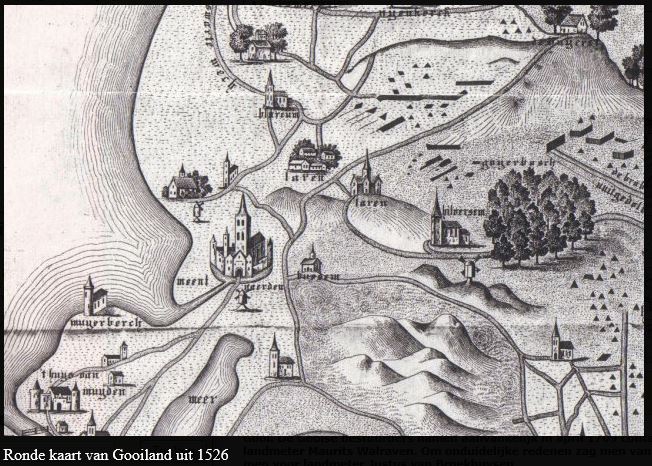
One windmill west of Naarden Vesting, one near Oud-Naarden, and one southwest of Hilversum.
The Blaricum windmill is not yet mentioned.
The first image of the Blaricum windmill on a map dates from 1537 (see image below). The windmill was probably built around 1530.
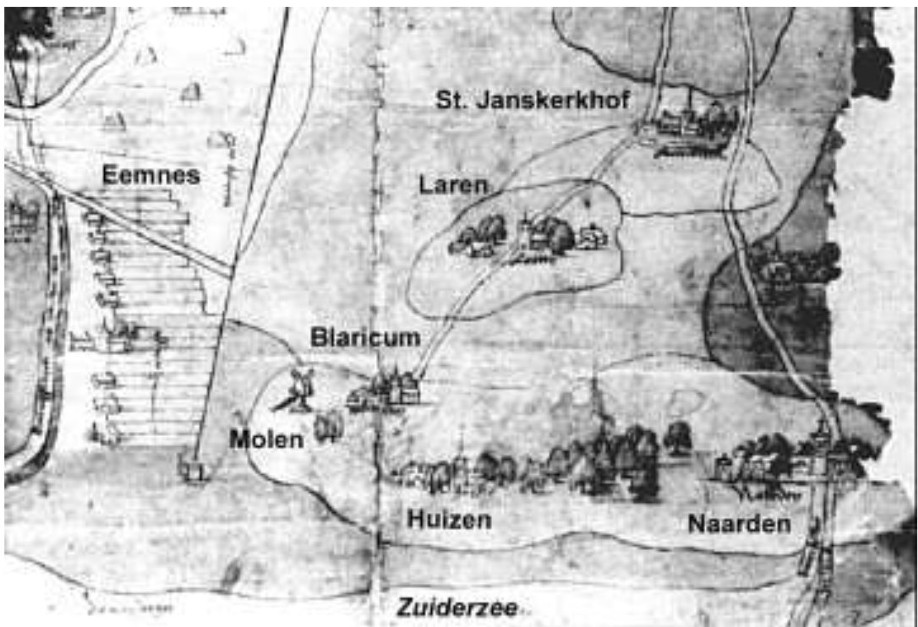
The windmill and the Reformed Church of Blaricum are clearly visible in the engraving from 1612 below.
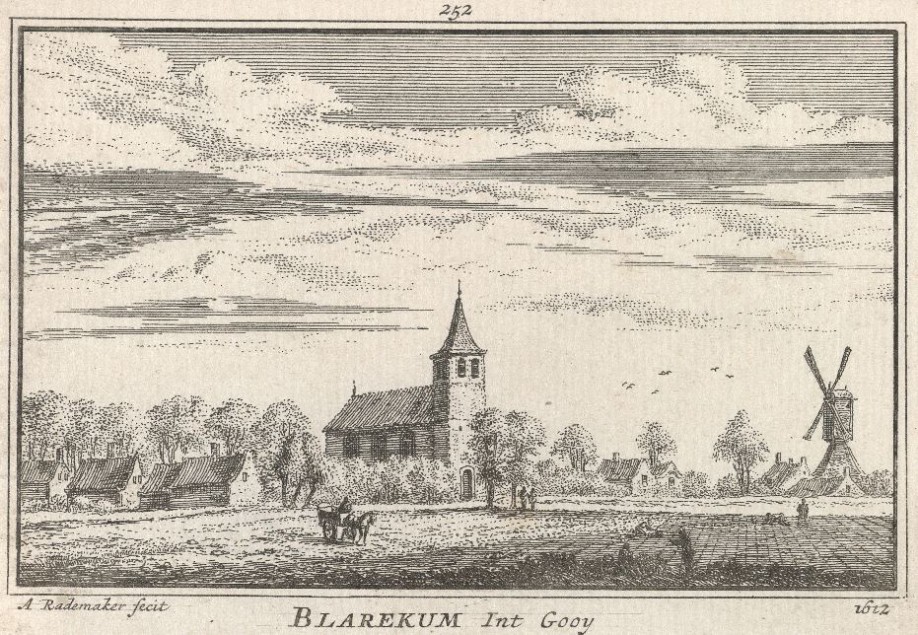
The mill was a corn mill (a standard type).
The photo below shows such a windmill; it is located in the Open Air Museum in Arnhem.
(Origin: location wasHuizen, built in 1665 and moved to Blaricum in 1916).
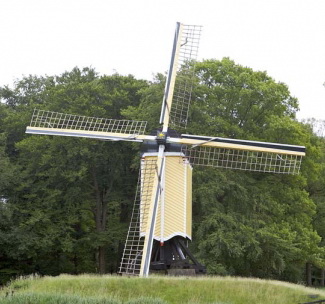
The Blaricum windmill is also depicted in an oil painting by the famous painter Jacob van Ruisdael (1628 - 1682)
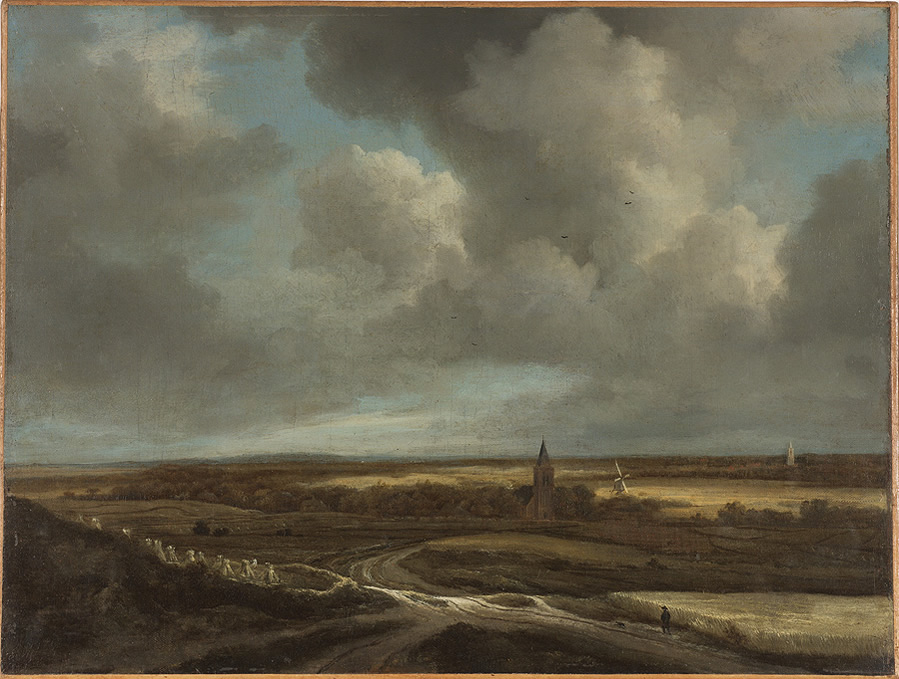
It was probably painted between 1660 and 1665.
The windmill has had many owners over the centuries.
The first written mention of this windmill appears in a deed of sale dated April 29, 1627, which concerned the sale of a piece of land near the mill.
A deed of sale dated May 23, 1652, concerned Goosen Rouweltsz. from Eemnes-Buiten, who sold the rights to half of the wind-exposed mill in Blaricum to miller Willem Rutgers, also from the same village. The buyer of the other half of the Blaricum windmill is not mentioned. However, the names of the sellers of that other half are known. They were the heirs of Meijns, Matghen, Steffentghen, and Bertghen Hendricksz.
In 1663, miller Cornelisz. sold another half of the windmill. The new owner became Adriaen Lanphensen from Blaricum. He paid ƒ1,600 (Dutch florins), of which, according to the deed, ƒ300 was calculated for the immovable portion, and the remaining ƒ1,300 was intended for the movable portion. That same day, the buyer transferred his newly acquired property to Jan Gerritsen of Alphen for the same amount and under identical conditions.
On June 13, 1664, the entire windmill became Jan Gerritsen's property by buying out Willem Jansz. Deelen, the Blaricum miller who owned the other half. While there had previously been no wind certificate (a kind of permit for millers in those days), Jan Gerritsen applied for one in 1666. This became necessary when the bailiff from the Kennemerland office sent him a request for proof of wind clearance. Until then, such a right to free use of wind was to be granted by the bailiff of Gooiland (an official on behalf of a lord or lordship, charged with jurisdiction in their respective area). On Gerritsen's application for a wind lease, the domains' audit office issued a recommendation to the Count's audit office of Holland. This recommendation was: "Grant the Blaricum millers a wind lease on the same annual terms as those applicable to other Gooi millers. Wind rights were granted on a leasehold basis against payment of 7 pounds per year, which amount was to be paid to the Auditor of Kennemerland on behalf of the Count. The Blaricum miller had to pay retroactively from October 1, 1665." The wind lease was granted on October 5, 1666, just over a year later.
In 1725, the mill was sold again. According to the deed, the mill was transferred to Willem Cornelisz. Verwer on November 1 of that year. The mill, with all its furnishings—sails, ropes, millstones, etc.—changed ownership for ƒ900.
In 1757, Verwer's heirs pledged their mill as a special pledge to the States of Holland and West Friesland for the sum of ƒ500. A statement from the bailiff and aldermen of Blaricum exists stating that the Verwer children were the legal owners.
Old records from the Roman Catholic St. Vitus Church in Blaricum indicate that the Blaricum windmill came into the possession of miller Gerrit Willemse Puyk during the 1830s. Gerrit was born on December 21, 1805, the son of Willem Lammert Puyk and Marretje Rozendaal. Gerrit was married to Gijsbertje Jacobse Heerschop and had two sons, Willem and Jan, and a daughter, Marritje.
In 1873, the old windmill was demolished.
A new windmill!
The history of the Blaricum mill didn't end there. A new mill was built on the site of the old mill. This mill came from Baarn and stood on Jacob van Lenneplaan between numbers 43 and 45.
The windmill was built in 1759 in the hamlet of Zandvoort near Baarn and was named the Santvoortsche Molen (Santvoort Mill). This mill replaced a mill that belonged to Drakenburch Castle. In 1756, miller Jan Gerritsz. Varekamp petitioned the States of the Sticht (Sticht) to replace and relocate this mill. Three years later, Jan Lucas van der Dussen commissioned millwrights to Jan and Gerrit van der Wouden to build a new hexagonal, thatched corn mill with a ground sail for the sum of 4,700 guilders. The sails and millstones from the old mill were to be reused in the reconstruction.
The mill changed hands in a short period of time. In 1873, the miller Jacob Versteeg sold the mill due to ill health and the lack of a successor. The buyer was Taack Takranen, who in turn sold the parts. The mill was dismantled and transported to Blaricum. There, the hexagonal mill was rebuilt. Thus, a second corn mill was built on the same site where a mill once stood.
Willem Puijk and his brother Jan operated the mill. Jan and Lambert, the two sons of their sister Marritje, also helped in the business. They had both become millers by profession. They lived with their children on the farmhouse next to the mill.
The mill remained in operation until 1921. The last owner/miller was Willem Puijk, who died on October 9, 1922, at the age of 87.
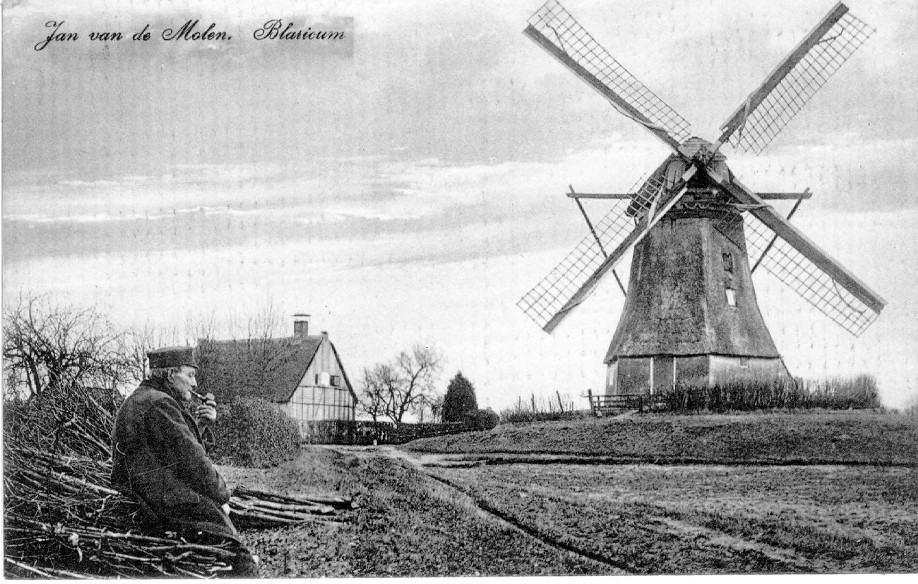
The photo above shows the mill with Jan Puyk, miller Willem's brother, on the left.
In 1923, the mill changed ownership. Two foreign women, the De Virieu Fürstner sisters, became the new owners. They bought the mill for ƒ4,500 from the mill's last miller, Jan Puyk. The women wanted to live in the mill.
After applying for a permit to renovate the mill, they had already begun demolishing the workings. Pieces of thatched roof had already been removed to install larger windows. However, the request was denied. In 1923, the year the Dutch Mill Association (De Vereeniging De Hollandsche Molen) was founded, a request had been sent to all Dutch municipalities to preserve as many of the mills as possible. No permit was issued for the mill to convert it into a residential mill.
The mill and its land were sold back to the municipality for a much lower sum, namely ƒ1,500. Mayor Klaarenbeek (term of office 1922-1946) wanted to persuade the municipality to acquire ownership of the mill and also to pay for the restoration work. According to calculations by mill builder Wijnveen from Voorthuizen, which had been verified by the expert Dekker from Hazerswoude, the restoration (using secondhand parts) would cost ƒ4,950.
The prospective tenant for the restored mill was Lambert Vos, who wanted to rent it for ƒ260 per year for 10 years. The municipality could borrow the ƒ5,500 to be provided at 5%, which is ƒ275 per year. While this was feasible, annual maintenance and loan depreciation were not mentioned. Because the council was surprised by this proposal and disagreed with the mayor's actions in general, it was rejected by an overwhelming majority.
In July 1925, a collection was still being held among the population for the preservation of the mill. Its decline quickly set in. The dilapidated mill was regularly used by homeless people as a sleeping place, which could pose a fire hazard if they lit a fire there. Attempts by the mayor to save the mill, with the help of the "De Hollandsche Molen" (Dutch Mill) association and the "Blaricums Belang" (Blaricum Interest) association, failed.
Therefore, in April 1928, the municipality decided to have the mill demolished by contractor Gerard Jacobs.
